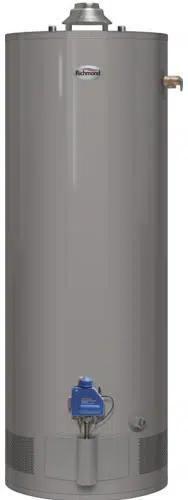Documents: Go to download!
User Manual
- User Manual - (English)
- Technical Specifications - (English)
- Spec Sheet (web) - (English)
- Product Comparison - (English)
- Warranty - (English)
- Installation Instructions - (English)
- Energy Guide - (English)
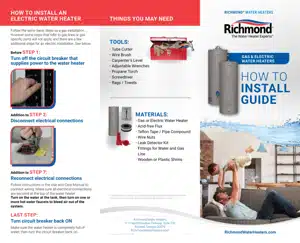
- Installing the water heater
- Operating the water heater
- Care and cleaning of the water heater
- Troubleshooting Tips
Table of contents
User Guide Water Heater
Installing the water heater
Location
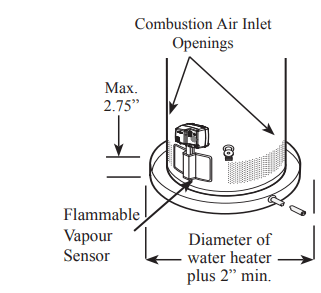
The water heater should not be located in an area where leakage from the tank or connections will result in damage to the area adjacent to the heater or to lower floors of the structure.
When such areas cannot be avoided it is recommended that a suitable drain pan, adequately drained, must be installed under the water heater.
The water heater must be centered in the drain pan.
The drain pan must not restrict air flow to the combustion air inlet openings perforation openings) located around the lower perimeter of the water heater.
Drain pan kits are available from the store where the water heater was purchased, or any water heater distributor.
Make certain the floor underneath the water heater is strong enough to sufficiently support the weight of the water heater once it is filled with water.
A gas fired water heater or any other appliance should not be installed in a space where liquids which give off flammable vapours are to be used or stored. Such liquids include gasoline, LP gas (butane or propane), paint or adhesives and their thinners, solvents or removers.
DO NOT block or obstruct any of the combustion air inlet openings located around the perimeter of the water heater. A minimum of 1 in. is required between these combustion air inlet openings and any obstruction.
DO NOT obstruct or block the Flammable Vapour Sensor.
Because of natural air movement in a room or other enclosed space, flammable vapours can be carried some distance from where liquids which give off flammable vapours are to be used or stored. The open flame of the water heater’s pilot or main burner can ignite these vapours and create a shut down condition of the water heater which will not allow the water heater to ignite until examined by a Qualified Service Technician.
FVIR certified gas water heaters can be installed on a residential garage floor without the use of an 18-inch stand in accordance with the National Fuel Gas Code, NFPA 54, ANSI Z223.1, unless otherwise directed by State and Local code requirements. The water heater must be located so it is not subject to physical damage, for example, by moving vehicles, area flooding, etc.
- Hot water lines should be insulated to conserve water and energy.
- The water heater and water lines should be protected from exposure to freezing temperatures.
- DO NOT install the water heater in bathrooms, bedrooms, any occupied rooms normally kept closed, or in unprotected outdoor areas.
- Minimum clearance from combustible construction:

* "Front" clearance dimension is measured from the gas control thermostat) to the closet door.
** "Top" clearance dimension is measured from the jacket top to the ceiling.
If the clearances stated on the Instruction/ Warning Label, located on the front of the heater differ, install the water heater according to the clearances stated on the label.
- If the water heater is installed in an alcove or closet, the entire floor must be covered by a wood or metal panel. A minimum of 24 in. clearance from the front and top should be available for adequate inspection and servicing.
- The water heater may be installed on combustible floors, but not directly on carpeting. If the water heater must be installed on carpeting, place a metal or wood panel beneath the water heater, extending beyond its full width and depth at least 3 in. in all directions.
NOTICE: For proper operation and maintenance, a minimum clearance of 1.5 inches must be provided from the combination temperature and pressure relief valve to any wall or object.
Inspect Shipment
- Inspect the water heater for possible damage. Check the markings on the rating plate of the water heater to be certain the type of gas supplied corresponds to the water heater requirements
Combustion and Ventilation Air
- Proper operation of the water heater requires air for combustion and ventilation. Provisions for combustion and ventilation air must comply with referenced codes and standards.
- DO NOT block or obstruct any of the combustion air inlet openings located around the perimeter of the water heater. A minimum of 1 in. is required between these combustion air inlet openings and any obstruction.
NOTICE: If the water heater is installed in an unconfined space within a building of conventional frame, masonry or metal construction, infiltration air is normally adequate for proper combustion and ventilation. If the water heater is installed in a confined space, provisions for combustion and ventilation air must be made.
- DO NOT obstruct or block the Flammable Vapour Sensor.
- A confined space is one having a volume of less than 50 cubic feet per 1000 Btu/h of the aggregate input of all appliances within that space.
- The air must be supplied through two permanent openings of equal area. One is to be located within 12 in. above the floor and the other is to be located within 12 in. from the ceiling
- The minimum net free area of each opening must not be less than one square inch per 1000 Btu/h of the total input rating of all the appliances in the enclosure (but not less than 100 square inches), if each opening communicates with other unconfined areas inside the building.
- Buildings of unusually tight construction shall have the combustion and ventilation air supplied from outdoors, or a freely ventilated attic or crawl space.
- If air is supplied from outdoors, directly or through vertical ducts, there must be two openings located as specified above and each must have a minimum net free area of not less than one square inch per 4000 Btu/h of the total input rating of all the appliances in the enclosure.
- If horizontal ducts are used to communicate with the outdoors, each opening must have a minimum net free area of not less than one square inch per 2000 Btu/h of the total input rating of all the appliances in the enclosure. If ducts are used, the minimum dimensions of rectangular air ducts shall not be less than 3 in
NOTICE: If the duct openings which supply combustion and ventilation air are to be covered with a protective screen or grill, the net free area (openings in the material) of the covering material must be used in determining the size of the openings. Protective screening for the openings MUST NOT be smaller than 1/4 in. mesh to prevent clogging by lint or other debris.
Corrosive Atmospheres
The air in beauty shops, dry cleaning establishments, photo processing labs, and storage areas for liquid and powdered bleaches or swimming pool chemicals often contain such halogenated hydrocarbons
An air supply containing halogenated hydrocarbons may be safe to breathe, but when it passes through a gas flame corrosive elements are released that will shorten the life of any gas burning appliance.
Propellants from common spray cans or gas leaks from A/C and refrigeration equipment are highly corrosive after passing through a flame.
The water heater warranty is voided when failure of the heater is due to operation in a corrosive atmospher
Thermal Expansion
Determine if a check valve exists in the inlet water line. Check with your local water utility company. It may have been installed in the cold water line as a separate back flow preventer, or it may be part of a pressure reducing valve, water meter or water softener. A check valve located in the cold water inlet line can cause what is referred to as a “closed water system”. A cold water inlet line with no check valve or back flow prevention device is referred to as an “open” water system.
As water is heated, it expands in volume and creates an increase in the pressure within the water system. This action is referred to as thermal expansion”. In an “open” water system, expanding water which exceeds the capacity of the water heater flows back into the city main where the pressure is easily dissipated.
A “closed water system”, however, prevents the expanding water from flowing back into the main supply line, and the result of thermal expansion” can create a rapid and dangerous pressure increase in the water heater and system piping. This rapid pressure increase can quickly reach the safety setting of the relief valve, causing it to operate during each heating cycle. Thermal expansion, and the resulting rapid, and repeated expansion and contraction of components in the water heater and piping system can cause premature failure of the relief valve, and possibly the heater itself. Replacing the relief valve will not correct the problem!
The suggested method of controlling thermal expansion is to install an expansion tank in the cold water line between the water heater and the check valve (see illustration below). The expansion tank is designed with an air cushion built in that compresses as the system pressure increases, thereby relieving the over pressure condition and eliminating the repeated operation of the relief valve. Other methods of controlling thermal expansion are also available. Contact your installing contractor, water supplier or plumbing inspector for additional information regarding this subject.
Water Supply Connections
Refer to the illustration below for suggested typical installation. The installation of unions or flexible copper connectors is recommended on the hot and cold water connections so that the water heater may be easily disconnected or servicing if necessary. The HOT and COLD water connections are clearly marked and are 3/4 in. NPT on all models. Install a shut-off valve in the cold water line near the water heater.
Typical Installation

Relief Valve
The pressure rating of the relief valve must not exceed 150 psi, the maximum working pressure of the water heater as marked on the rating plate
The Btu/h rating of the relief valve must equal or exceed the Btu/h input of the water heater as marked on its rating plate. Position the outlet of the relief valve above a suitable open drain to eliminate potential water damage. Piping used should be of a type approved for hot water distribution.
The discharge line must be no smaller than the outlet of the valve and must pitch downward from the valve to allow complete drainage (by gravity) of the relief valve and discharge line.
The end of the discharge line should not be threaded or concealed and should be protected from freezing. No valve of any type, restriction, or reducer coupling should be installed in the discharge line.
To Fill the Water Heater
Make certain that the drain valve is closed, then open the shut-off valve in the cold water supply line on the water heater.
Open each hot water faucet slowly to allow the air to vent from the water heater and piping.
A steady flow of water from the hot water faucet(s) indicates a full water heater.
DO NOT allow the flammable vapour sensor to become submerged in water.
Condensation
Condensation can form on the tank when it is first filled with water. Condensation might also occur with a heavy water draw and very cold inlet water temperatures.
Drops of water falling on the burner can produce a sizzling or pinging soun
This condition is not unusual, and will disappear after the water becomes heated. If, however, the condensation continues, examine the piping and fittings for possible leaks.
Gas Supply
The branch gas supply line to the water heater should be clean 1/2 in. black steel pipe no more than 40 equivalent feet long or other approved gas piping material.
An union or ANSI design certified semirigid or flexible gas appliance connector should be installed in the gas line close to the water heater. The National Fuel Gas Code (NFGC) mandates a manual gas shut-off valve: See (NFGC) for complete instructions.
If flexible connectors are used, the maximum length shall not exceed 36 in. and must meet the requirements in ANSI Z21.24-Connectors for Gas Appliances.
Compound used on the threaded joints of the gas piping must be of the type resistant to the action of LP gas. Use compound sparingly on male threads only.
Where a sediment trap is not incorporated as part of the appliance, a sediment trap shall be installed downstream of the equipment shutoff valve as close to the inlet of the appliance as practical at the time the appliance installation The sediment trap shall be either a tee fitting with a capped nipple in the bottom outlet or other device recognized as an effective sediment trap.
DO NOT use excessive force (over 31.5 ft lbs.) in tightening the pipe joint at the gas control (thermostat) inlet, particularly if teflon pipe compound is used, as the valve body may be damaged.
The inlet gas pressure to the water heater must not exceed 10.5 in. w.c. for natural gas, or 14 in. w.c. for LP gas. For purposes of input adjustment, the minimum inlet gas pressure (with main burner on) is shown on the water heater rating plate. If high or low gas pressures are present, contact your gas supplier for correction.
Leak Testing
The water heater and its gas connections must be leak tested at normal operating pressures before it is placed in operation.
- Turn on the manual gas shut-off valve near the water heater.
- Use a soapy water solution to test for leaks at all connections and fittings. Bubbles indicate a gas leak that must be corrected.
The factory connections to the gas control thermostat) should also be leak tested after the water heater is placed in operation.
Venting
- This water heater is a Category I -Fanassisted appliance. This water heater must be vented with either three (3) inch or four (4) inch, double wall, Type B vent connectors as shown below. Vent connectors must be securely attached to the inducer outlet to connect the water heater to the gas vent or chimney. The vent connectors must be the same size diameter) as the inducer outlet or larger, never smaller.
- For proper venting in certain installations a larger vent connector size may be needed. Consult the Vent Tables in of the National Fuel Gas Code (ANSI Z223.1/NFPA 54).
- Multi-story and common venting is permitted. Consult the latest version of the National Fuel Gas Code (ANSI Standard Z223.1/NFPA 54)
- Horizontal vent connectors must be pitched upward to the chimney at least 1/4 in. per linear foot. Vent joints must be securely fastened by sheet metal screws or other approved method.
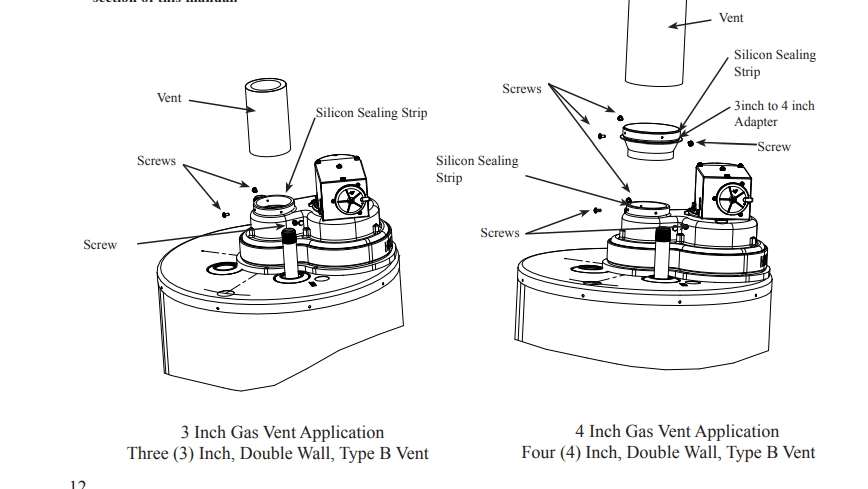
Wiring
- If local codes permit, the water heater may be connected to electric service with the power cord provided (DO NOT use an extension cord). A grounding receptacle is required
- If local codes DO NOT permit the use of cord connections, a 120 V, 50/60 Hz power supply, with suitable disconnecting means, must be connected to the black and white leads in the heater control enclosure
- A knock-out hole is provided to permit use of conduit or metal-clad cable connectors.
- The maximum current draw is approximately 5.0 amps.
- The water heater must be electrically grounded in accordance with local codes, or, in the absence of local codes, in accordance with latest edition of the National Electric Code ANSI/NFPA No. 70. Refer to the figures below for water heater internal wiring.
NOTE: It is not recommended that this unit be installed on a GFCI circuit.
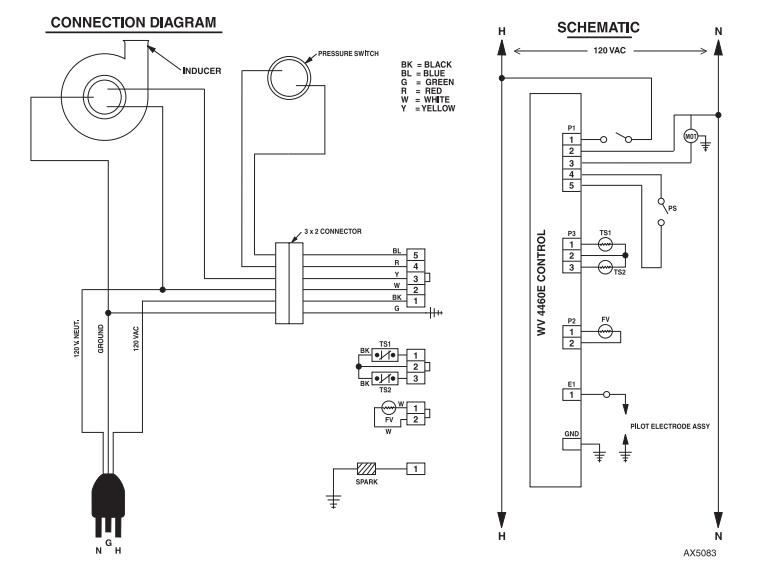
Hot and Cold Pipe Insulation Installation

- For increased energy efficiency, some water heaters have been supplied with two 24 in. sections of pipe insulation.
- Please install the insulation, according to the illustrations above, that best meets your requirements.
T&P Insulation Installation
For increased energy efficiency, this water heater has been supplied with a 2 3/8 in. section of T&P insulation. Please install the insulation as shown below

Slip the insulation cover over the T&P Valve through the center hole and align the hole in the side with the opening of the T&P Valve.
Ensure the T&P Valve opening is not obstructed by the insulation.
Heat Traps
For increased energy efficiency, some water heaters have been supplied with factory installed 3/4 in. NPT heat traps in the hot outlet line and cold water inlet line.
These heat traps may require a minimum of one (1) 90° 3/4 in. NPT elbow and may require an additional 90° 3/4 in. NPT elbow or a 3/4 in. coupling depending on your installation needs. See Illustration of nipples and heat traps on page 29.
During Installation of this water heater...........
DO
- DO check inlet gas pressure with main burner ON to ensure that it is within the range specified on the rating plate.
- DO provide adequate air for combustion and ventilation as discussed in the Use and Care Manual and the National Fuel Gas Code.
- DO maintain proper clearances to combustibles as specified on the rating plate.
- DO ensure that the venting system complies with the guidelines found in the Use and Care Manual and National Fuel Gas Code.
- DO contact a qualified service technician if the main burner will not stay lit. The burner chamber is designed to be sealed utilizing a gasket and tamper resistant screws.
DON’T
- DON’T block or restrict Combustion Air Inlet Openings or the Flammable Vapour Sensor located around the lower portion of the water heater jacket.
- DON’T remove the Burner Access Door unless absolutely necessary. This should only be done by a qualified service technician. A new burner access door gasket must be installed on any burner access door that has been removed.
- DON’T install this water heater where standing water may occur. The base of the water heater is meant to be mounted on a dry surface.
- DON’T allow cleaners, solvents, or other materials to come into contact with the Flammable Vapour Sensor.
- DON’T operate the water heater if the sight glass or burner access door grommet is damaged or broken.

Typical Piping Diagram for Combination Potable/Space Heating Installation
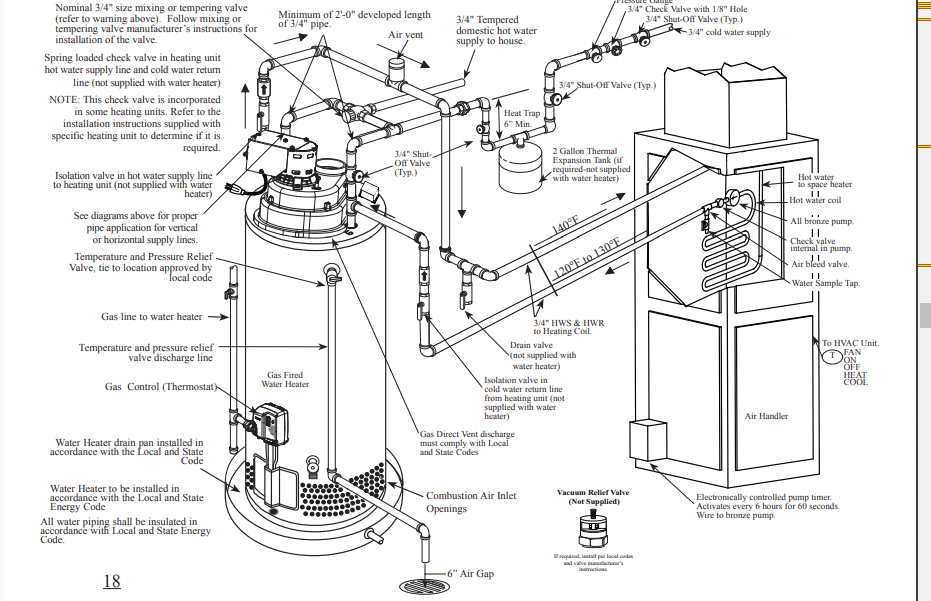
Operating the water heater
Operating Procedure
This heater is equipped with an electronically lit pilot to light the main burner. The pilot is automatically lit each time there is a demand for heating the water. On initial start-up, it is recommended that the outer door be removed (leave inner door in place for safety) to determine if the pilot and main burner are operating properly.
Once filled with water, it is necessary to plug the power cord in and make sure the ON/OFF” switch located on the blower assembly is in the “ON” position and the gas control (thermostat) switch is in the “ON” position. The blower will start and within seconds the pilot will light followed by the main burner. After the main burner ignites, replace the outer door.
If no main burner flame is established, the gas control (thermostat) will go through three trials for ignition before going into a lock-out. A warning light will alert the user of this lock-out condition. If this happens, refer to “Troubleshooting Guide.”
Water Temperature Setting
The temperature of the water in the water heater can be regulated by turning the knob on the front of the gas control (thermostat). Safety and energy conservation are factors to be considered when selecting the water temperature setting of the water heater’s gas control thermostat). The lower the temperature setting, the greater the savings in energy and operating costs.
To comply with safety regulations, the gas control (thermostat) was set at 120°F before the water heater was shipped from the factory. The recommended starting point temperature is 120°F.
Water temperatures above 125°F can cause severe burns or death from scalding. Be sure to read and follow the warnings outlined in this manual and on the label located on the water heater near the gas control (thermostat).
Mixing valves are recommended for reducing point of use water temperature by mixing hot and cold water in branch water lines. It is recommended that a mixing valve complying with the Standard for Temperature Actuated Mixing Valves for Hot Water Distribution Systems, ASSE 1017 be installed. See page 4 for more details and contact a licensed plumber or the local plumbing authority for further information.
The chart on the next page may be used as a guide in determining the proper water temperature for your home.
Maximum water temperatures occur just after the burner has shut off. To determine the water temperature, turn on a hot water faucet and place a thermometer in the water stream.
A condition known as “stacking” or “layering” can occur when a series of short and frequent hot water draws are taken.
The hottest temperature water will be at the top of the tank, closest to the outlet pipe delivering hot water to the home.
Stacking can cause this top layer of water to be hotter than the water toward the bottom of the tank near the gas control (thermostat). Therefore, always remember to test the water temperature with your hand before use and remember that hotter water increases the risk of scald injury.
Also, always supervise young children or others who are incapacitated.
The gas control (thermostat) is constructed with a built in safety shutoff device designed to shut off the gas supply to the burner if the main burner is extinguished for any reason.
The gas control (thermostat) is also equipped with a gas shutoff device that will shut off the gas supply to the burner if the water heater exceeds normal operating temperatures. Refer to the “Before You Call For Service” section of this manual, or contact your dealer
WARNING: Should overheating occur or the gas supply fail to shut off, turn off the manual gas control (thermostat) to the appliance
NOTICE: Replace any part of the gas control (thermostat) system which has been under water.
If the water heater has been subjected to fire, flood or physical damage, turn off the manual gas (shut-off) valve, and DO NOT operate the water heater again until it has been checked by a qualified service technician.
NOTICE: DO NOT use this appliance if any part has been under water. Immediately call a qualified installer or service agency to replace a flooded water heater. DO NOT attempt to repair the unit! It must be replaced.

Sequence of Operation…
1. During initial start-up or a call for heat, the control will verify the vacuum switch is open.
2. Once the control verifies the blower vacuum switch is open, the control will energize the blower motor for the pre-purge sequence (approximately 5 seconds).
3. The control will verify the blower vacuum switch has closed, ensuring that the blower is functioning properly and that the venting system is not blocked.
4. The control will then proceed through a sequence of self-diagnostics before initiating a trial for ignition.
5. During the trial for ignition, the pilot will spark in an attempt to light the pilot. Once the pilot flame is established, the main gas control (thermostat) will open allowing gas to flow to the main burner.
6. The main burner and pilot will remain lit throughout the heat cycle until the water temperature setting is reached.
7. Once the water temperature setting is reached, the control will close the main gas control (thermostat) and pilot valve which will extinguish both the main burner and pilot burner flames.
8. The blower motor will stay energized for an additional 30 seconds after the control verifies that the burner flame is extinguished in order to clear combustion gases from the water heater.
9. After the post-purge sequence, the control will de-energize the blower motor and go into a stand-by mode awaiting the next call for heat.
This water heater is equipped with a flammable vapour sensor that is monitored continuously by the electronic control in all modes of operation.
In the event that flammable vapours are detected, the control will automatically shut down the water heater and prevent the water heater from being started again.
The following is a list of materials that will cause the Flammable Vapour Sensor to shut down the water heater.
- Vapours of Gasoline.
- Vapours of certain flammable paints, stains, and thinners.
- Vapours of vent pipe Cement & Solvents.
- Bleach (direct contact with flammable vapour sensor).
- Some other flammable materials and their vapours.
If the flammable vapour sensor shuts down the water heater, then the electronic control will display the appropriate error code and you should then promptly contact a qualified service technician.
Refer to the “NOTICE” on page 3 for additional information.
Care and cleaning of the water heater
Draining the Water Heater
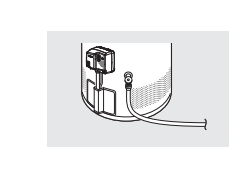
CAUTION: Shut off gas to the water heater at the gas control (thermostat) gas cock or manual shutoff valve before draining water
DANGER: Before manually operating the temperature and pressure relief valve, make certain no one will be exposed to the hot water released by the valve. The water drained from the tank may be hot enough to present a scald hazard and should be directed to a suitable drain to prevent injury or damage.
Before turning off the cold water supply to the water heater, open a hot water faucet allowing sufficient cold water into the tank to prevent the risk of a scald injury while draining the water heater.Once the water in the tank is no longer hot, turn off the cold water supply to the water heater.Open a hot water faucet or lift the handle on the relief valve to admit air to the tank. Attach a garden hose to the drain valve on the water heater and direct the stream of water to a drain. Open the valve.
Attach a garden hose to the drain valve on the water heater and direct the stream of water to a drain. Open the valve.
Routine Preventative Maintenance
Properly maintained, your water heater will provide years of dependable trouble-free service.
It is recommended that a periodic inspection of the gas control (thermostat), burner, relief valve, internal flue-way and venting system should be made by service personnel qualified in gas appliance repair.
It is suggested that a routine preventative maintenance program be established and followed by the user.
At least once a year, lift and release the lever handle on the temperature pressure relief valve, located near the top of the water heater, to make certain the valve operates freely. Allow several gallons to flush through the discharge line to an open drain.
NOTICE: If the temperature and pressure relief valve on the water heater discharges periodically, this may be due to thermal expansion in a closed water system. Contact the water supplier or your plumbing contractor on how to correct this. DO NOT plug the relief valve outlet.
A water heater’s tank can act as a settling basin for solids suspended in the water. It is therefore not uncommon for hard water deposits to accumulate in the bottom of the tank. If allowed to accumulate, these solids can cover the gas control (thermostat) sensors, causing the sensors to operate erratically. Because accumulated solids can prevent the gas control (thermostat) sensors from accurately reading the water temperature, the water at the fixture can be hotter than the gas control (thermostat) setting. It is suggested that a few quarts of water be drained from the water heater’s tank every month to clean the tank of these deposits.
Rapid closing of faucets or solenoid valves in automatic water using appliances can cause a banging noise heard in a water pipe. Strategically located risers in the water pipe system or water hammer arresting devices can be used to minimize the problem
The anode rod should be removed from the water heater’s tank annually for inspection and replaced when more than 6 in. of core wire is exposed at either end of the rod.
Make sure the cold water supply is turned off before removing anode rod.
This water heater incorporates a combustion shut off device that shuts the operation of the water heater down if undesirable combustion conditions occur, such as the presence of flammable vapours or blockage of the combustion air inlet openings. Please contact a Qualified Service Technician if this occurs.
Housekeeping
Visually inspect the pilot.
To ensure sufficient ventilation and combustion air supply, proper clearances must be maintained.
When installed in a closet, DO NOT block or obstruct any of the combustion air inlet openings located around the perimeter of the water heater. A minimum of 1 in. is required between these combustion air inlet openings and any obstruction.
DO NOT obstruct or block the Flammable Vapour Sensor. The sensor does not require any maintenance or cleaning.
DO NOT expose to cleaning agents.
Venting System Inspection
The water heater’s internal flue must be inspected annually to be certain it is clean by removing the inducer and flue baffle.
When reinstalling the flue baffle make certain it is hung securely by its hanger at the top of the flue way.
Reinstall the inducer.
Inspect the gas venting system and the chimney.
Make certain the vent connector from the inducer outlet to the chimney is properly positioned and securely attached.
If after inspection of the vent system you found soot or deterioration; call the local gas utility to correct the problem and clean the flue, or replace the flue, flue baffle, and venting system before resuming operation of the water heater.
Burner Inspection
Visually inspect the pilot flame and main burner annually.
Through the sight glass, inspect the pilot and burner lighting. If any unusual pilot or burner operation is noted, the water heater should be shut off until qualified service assistance can be obtained.
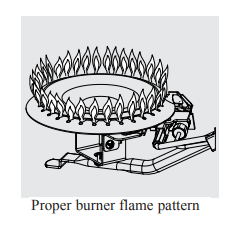
CAUTION: For your safety, cleaning of the burner must be performed only by qualified service personnel, as it involves the disconnection of gas piping and leak testing.The burner chamber is a sealed area. If the burner access door is removed, the burner access door gasket must be replaced.
For cleaning, remove the burner from the water heater. A vacuum cleaner can be used on the burner and floor shield inside the water heater. The burner can also be cleaned by scrubbing with mild detergent.
Vacation and Extended Shut-Down
If the water heater is to remain idle for an extended period of time, the power and water to the appliance should be turned off to conserve energy and prevent a build-up of dangerous hydrogen gas.
The water heater and piping should be drained if they might be subjected to freezing temperatures
After a long shut-down period, the water heater’s operation and controls should be checked by qualified service personnel. Make certain the water heater is completely filled again before placing it in operation.
Anode Rod
This water heater is equipped with an anode rod designed to prolong the life of the glass lined tank. The anode rod is slowly consumed, thereby eliminating or minimizing corrosion of the glass lined tank.
Water sometimes contains a high sulfate and/or mineral content and together with cathodic protection process can produce a hydrogen sulfide, or rotten egg odor in the heated water. Chlorination of the water supply should minimize the problem
Troubleshooting Tips
Before You Call For Service
Condensation
- This usually happens when a new water heater is filled for the first time.
- This is normal. After the water in the tank warms a new water heater is up, the condensation will disappear. If, however, the filled for the first time. condition persists, examine the piping and fittings for possible leaks.
- Moisture from the products on the tank surface
- This is normal and will disappear in time. Excessive of combustion condensing condensation can cause main burner outage
- An undersized water will cause of your needs. condensation.
- Use a water heater size that meets the requirements of you need
Yellow flame or soot
- Scale on top of the burner
- Contact a qualified service technician to remove scale.
- Flue or Combustion air inlet openings are restricted
- Remove obstruction or debris from flue or openings are restricted. combustion air inlet openings on water heater jacket.
- Not enough combustion or ventilation air supplied to the water heater location.
- Proper operation of the water heater requires air for ventilation air supplied to combustion and ventilation. See the Combustion and the water heater location. Ventilation Air information in the “Installing The Water Heater” section of this manual.
Unable to light the main burner
- Air in gas line
- Contact a qualified service technician to purge the air the main burner from the gas line
- Blocked Exhaust
- Contact a qualified service technician to evaluate vent pipe for blockage
- Pressure Switch
- Make sure the pressure switch hose is not "kinked"
- Wire Connection not fully wire secured
- Contact a qualified service technician to confirm wire secured. connections
- Combustion Shut-off Device tripped
- Combustion shut-off device should be inspected by a tripped. qualified service technician.
- Gas Control (Thermostat) Problem
- Contact a qualified service technician
Main burner does not stay lit
- Combustion Shutoff Device Tripped
- The combustion shutoff device should be inspected stay lit Tripped. by a qualified service technician
Rumbling noise
- Scale and sediment
- Drain the water heater to remove scale and sediment from the tank. Refer to the top of page 24.
Relief valve producing popping noise or draining
- Pressure build up expansion to a contractor on how to correct this closed system
- This is an unacceptable condition and must be producing popping caused by thermal corrected. Contact the water supplier or plumbing noise or draining expansion to a contractor on how to correct this. DO NOT plug the closed system. relief valve outlet.
Not enough or no hot water
- Water usage may have exceeded of the water heater
- Wait for the water heater to recover after an no hot water exceeded the capacity abnormal demand
- Low gas pressure
- Check gas supply pressure and manifold pressure
- The gas control (thermostat) may be set too low
- See the “Water Temperature Setting” of The Water may be set too low. Heater section of this manual
- Leaking or open hot water faucets.
- Make sure all faucets are closed.
- Check valve error codes
- Refer to "gas valve error codes" information on the "Gas Valve LED Codes" section of this manual.
- “ON/OFF” switch turned of
- Turn “ON”
- Inducer unplugged
- Plug in. Verify power supply (120VAC)
- Combustion Shutoff System tripped
- Contact a qualified service technician.
Water is too hot
- The gas control (thermostat) too high
- See the “Water Temperature Setting” of The Water is set too high. Heater section of this manual.
- Gas Control (Thermostat) Defective
- Contact a qualified service technician to replace the Defective. gas control (thermostat).
Gas Valve LED Codes
Short flash once every four seconds - IDLE (no call for heat, no fault conditions)
- Temperature setpoint achieved and burner is off
- No solution required
“Heartbeat”, alternates bright/dim - Call For Heat (no fault conditions)
- Water temperature is below setpoint and burner is on
- No solution required
One Flash, three second pause Low flame signal (control continues to operate)
- Pilot tube restriction, carbon buildup on electrode, pilot wire damage or gas supply
- Gas supply pressure is low
- Low voltage supply
- Pilot replacement
Two Flash, three second pause - Pressure switch failed closed
- Pressure switch tube blockage or faulty pressure switch.
- Pressure switch wiring incorrect
- Replace pressure switch
Three Flash, three second pause - Pressure switch failed open.
- Vent blockage or improper installation, switch tube blockage, faulty switch, blower improper operation or temperature switch open
- Pressure switch wiring incorrect
- Replace pressure switch
- Air intake or exhaust obstructed
- Replace blower temperature switch
- Replace blower
Four Flash, three second pause - TCO limit lockout
- Thermal well fault, gas control (thermostat) fault or tank is not filled with water
- Reset valve and check for proper valve cycling
- Make sure tank is full of water
Five Flash, three second pause - Flame out of sequence
- Pilot or burner valve has failed ope
- Replace gas control (thermostat)
Six-One Flash, three second pause - Failed trial for ignition
- Insufficient gas supply, unstable pilot, carbon buildup on electrode or wire/pilot tube damage
- Check gas supply
- Replace pilot
Six-Two Flash, three second pause: Recycle limit - PS/limit opened
- Vent blockage or improper installation, switch tube blockage, faulty switch, blower improper operation, blower temperature switch open or excessive wind at vent termination
- Pressure switch wiring incorrect
- Replace pressure switch
- Air intake or exhaust obstructed
- Replace blower temperature switch
- Replace blower
- Check for vent termination compliance as stated in this manual
Six-Three Flash, three second pause: Recycle limit - flame lost
- Pilot tube restriction, low gas supply pressure, carbon buildup on electrode, wire/pilot tube damage or combustion air port blockage
- Gas supply pressure is low
- Jacket air holes obstructed
- Pilot replacement
Six-Four Flash, three second pause: Soft Lockout - flame out of sequence sensed
- Valve stuck in open position
- Replace gas control (thermostat)
Seven Flash, three second pause - Flammable vapour sensor lockout
- Gasoline or other flammable gas was detected near the appliance or the sensor has failed
- Verify no gasoline or flammable vapours are present
- Reset control using ON/OFF switch on the gas control (thermostat)
- Replace the flammable vapour sensor
Eight-One Flash, three second pause: FVS fault detected
- Flammable vapour sensor resistance is out of range, wiring to FV sensor is faulty or control is faulty
- Replace FV sensor
- Replace FV sensor wiring
- Replace gas control (thermostat)
Eight-Two Flash, three second pause: Temperature sensor fault detected
- Thermal well fault
- Check thermal well wiring connection
- Replace thermal well
Eight-Three Flash, three second pause: Electronics fault detected
- Thermal well fault or gas control (thermostat) fault
- Replace gas control (thermostat)
- Replace thermal well
Eight-Four Flash, three second pause: Valve fault detected
- Gas control (thermostat) needs to be reset or has been damaged
- Cycle power to gas control (thermostat)
- Replace gas control (thermostat)
CAUTION: Make certain power to water heater is “OFF” before removing protective cover FOR ANY REASON.
CAUTION: Label all wires prior to disconnection when servicing controls. Wiring errors can cause improper and dangerous operation. VERIFY PROPER OPERATION AFTER SERVICING.
CAUTION: For your safety DO NOT attempt repair of gas piping, remote control, burners, vent connectors or other safety devices. Refer repairs to qualified service personnel.
See other models: 6G50S-40F3
